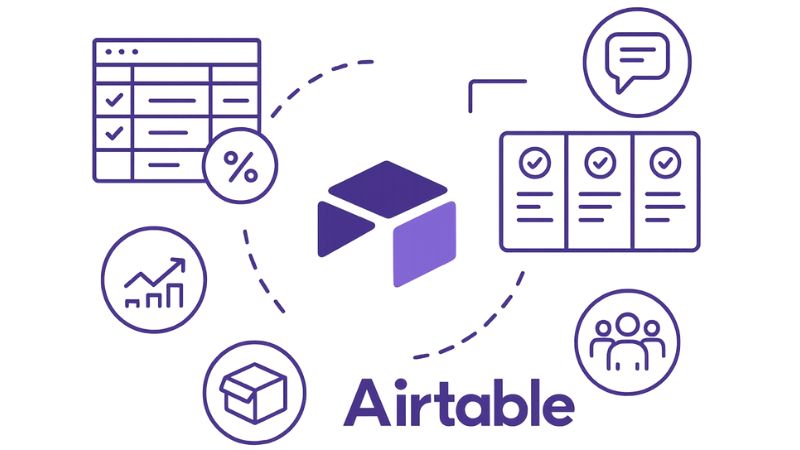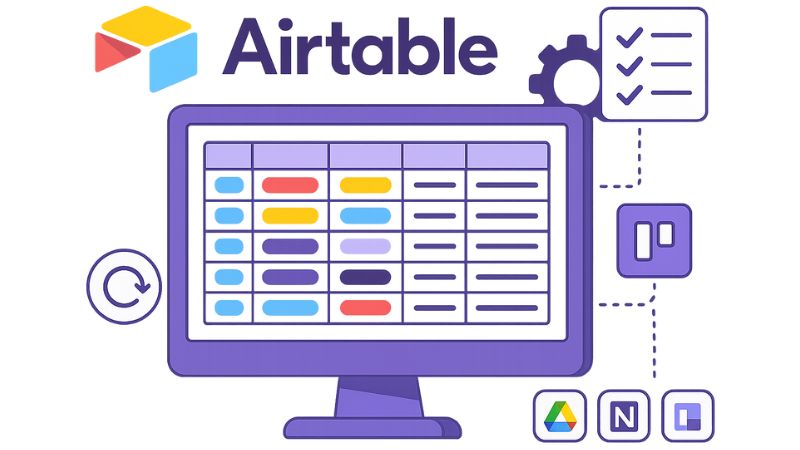Airtable
A detailed look at Airtable's uses and features
Creating a database becomes essential when managing data efficiently, whether you’re running a small business, handling marketing campaigns, or managing internal projects. However, traditional databases can often feel complex and intimidating for non-technical users. This is where Airtable steps in — a user-friendly, cloud-based platform that combines the simplicity of spreadsheets with the power of databases.
Airtable allows users to design highly visual, interactive databases that can be customized for virtually any workflow — from project management and content scheduling to customer relationship management and product inventories.

What is Airtable?
Airtable is an easy-to-use online spreadsheet-database hybrid that helps users store, organize, and collaborate on data with ease. Unlike traditional databases that require SQL scripting, Airtable allows anyone — even those with no programming experience — to create powerful applications visually.
The platform works much like a spreadsheet but offers relational database capabilities, enabling you to link data across multiple tables, automate tasks, and integrate with popular tools like Slack, Google Workspace, Notion, and Trello. This makes Airtable not only a productivity tool but also a scalable foundation for businesses to centralize their workflows.
Whether you’re creating an inventory tracker, managing event registrations, or tracking leads, Airtable provides the flexibility and speed to handle it all in one unified platform.

What is Airtable used for?
Airtable is versatile and can be adapted to a wide range of industries. Common use cases include:
- Project Management: Track tasks, milestones, and deadlines collaboratively.
- Marketing Campaigns: Manage campaigns, track performance metrics, and organize content calendars.
- CRM (Customer Relationship Management): Maintain contact records, follow-ups, and communications history.
- Content Production: Plan and schedule content across multiple channels.
- Event Planning: Organize logistics, track RSVPs, and manage vendor relationships.
- Inventory Management: Monitor stock, orders, and product variations in real time.
The platform’s customizable templates make it ideal for beginners and professionals alike — anyone can pick a template, adjust fields, and launch a solution in minutes.
What is the difference between Airtable and Excel?
While Excel and other spreadsheet programs focus primarily on number crunching and static data, Airtable bridges the gap between spreadsheets and databases. Unlike Excel, Airtable enables relational data linking — meaning that information stored in one table can be connected to another.
This makes it possible to manage complex relationships between different datasets. For instance, a business could link customer contact information to project details, invoices, and support tickets — all automatically updated and connected.
Additionally, Airtable includes advanced visualization tools such as Kanban boards, Gantt charts, calendars, and gallery views — giving you complete control over how you view and interact with your data.
Why is Airtable so popular?
1. Complete Software
Airtable functions as a full-fledged data management system while maintaining simplicity. Its flexibility makes it suitable for both individual creators and enterprise-level operations.
2. Ease of Use
Its drag-and-drop interface eliminates complexity, allowing users to create and modify records without code. Even beginners can automate repetitive tasks using prebuilt workflows and triggers.
3. Excellent Customization Options
Every field in Airtable can be formatted to fit your data needs — text, attachments, dropdowns, checkboxes, formulas, links, and more. This flexibility allows users to tailor their workspace to specific tasks.
4. Template Library
Airtable offers hundreds of ready-to-use templates covering marketing, design, HR, product management, and operations, helping teams set up fast and stay organized.
5. Seamless Collaboration
Airtable makes teamwork effortless. Users can leave comments, assign collaborators, and share views securely. Permissions and roles ensure data is always managed properly.
6. Automation and Integration
Airtable automations allow users to send emails, create records, or post updates in Slack automatically. With integrations for over 1,000 apps via Zapier, Make (Integromat), and Google Workspace, it easily connects to your existing tools.
Is Airtable free?
Airtable offers several pricing tiers to cater to individuals, small teams, and enterprises.
1. Free Plan
Ideal for personal or small-scale use. Includes unlimited bases, essential features, and up to 1,200 records per base.
2. Plus Plan – $10 per user/month
Adds 5 GB of attachments, 5,000 records per base, and a 6-month revision history. Great for small businesses.
3. Pro Plan – $20 per user/month
Includes advanced apps, Gantt charts, timeline views, and 20 GB of attachments. This plan suits medium-to-large teams managing complex projects.
4. Enterprise Plan – Custom Pricing
Designed for large organizations, offering unlimited workspaces, enhanced admin controls, SAML-based single sign-on, and priority support.
Advantages of Airtable
- No coding required: Ideal for non-technical users.
- Cloud-based flexibility: Access your data anywhere, anytime.
- Real-time collaboration: Multiple users can edit simultaneously.
- Integration power: Works with tools like Slack, Gmail, and Zapier.
- Data visualization: Transform spreadsheets into interactive dashboards.
- Automation: Reduce manual tasks using built-in workflow triggers.
Disadvantages of Airtable
- Limited offline access: Requires an internet connection for most features.
- Complex automations: May need third-party services for advanced workflows.
- Pricing for large datasets: Can become costly for enterprise-level usage.
- No native scripting: Custom scripting requires knowledge of Airtable’s scripting block or API.
Conclusion
Airtable stands out as one of the most accessible and powerful no-code platforms available today. It seamlessly merges the simplicity of spreadsheets with the structure of databases, empowering users to build customized workflows without needing technical skills.
From startups to Fortune 500 companies, Airtable is redefining how teams organize, collaborate, and manage data. Whether you’re automating marketing campaigns, tracking leads, or managing internal operations, Airtable’s blend of simplicity and sophistication makes it an indispensable tool for modern digital workspaces.
The No Code tools we use
Let's talk about your application, AI agent or automation.
Frequently asked questions about
We help you build businesses that are human, sustainable and much more efficient.
Yes. Airtable offers views like Kanban, Calendar, and Gantt charts, making it a flexible alternative to tools like Asana or Trello with added database power.
Partially. Airtable requires an internet connection for most functions. You can view some cached data offline, but editing usually needs to be done online.
Yes. Airtable’s built-in automation features let you trigger actions like emails, updates, or Slack messages — all without writing code.
Airtable uses SSL encryption, secure cloud hosting, and role-based permissions to protect sensitive data, making it safe for business use.
Absolutely. It connects with over 1,000 tools through Zapier, Make, and native integrations like Google Workspace, Slack, and Notion.



